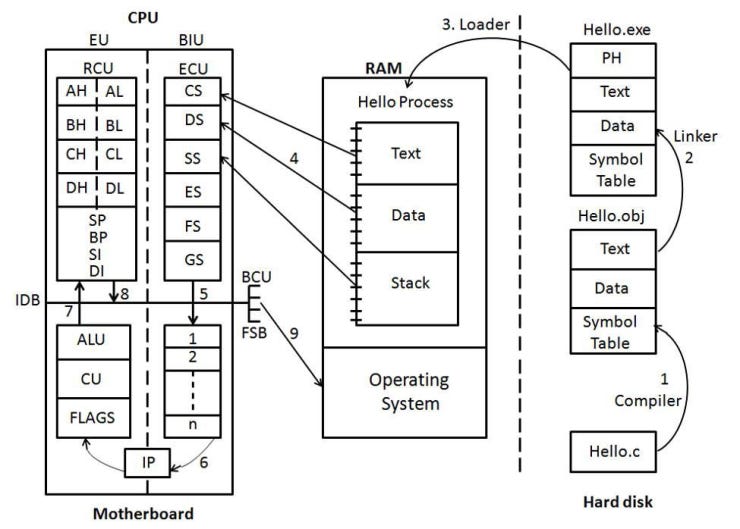How Your Code Runs: The Journey of a Program Through the CPU
The Role of Memory, Registers, and the ALU in Program Execution
Introduction
The Central Processing Unit (CPU) stands as the superior engine that powers everything from simple calculations to complex simulations. Understanding its architecture and execution flow is not just a matter of academic interest but a foundational step for anyone delving into programming or computer science. This blog post aims to explain the inner workings of the CPU by exploring its architecture, and execution flow, and illustrating these concepts with a practical code example.
CPU Architecture
At the heart of every computer lies the CPU, a marvel of engineering composed of several key components:
Control Unit (CU): The brain of the CPU, the Control Unit orchestrates the fetching, decoding, and execution of instructions. It ensures that the CPU's operations proceed in the correct sequence.
Arithmetic Logic Unit (ALU): Responsible for performing arithmetic and logical operations, the ALU is the workhorse of the CPU. Whether it's addition, subtraction, or comparison operations, the ALU handles it all.
Registers: These are the CPU's high-speed storage units, holding data and instructions temporarily. Registers like the Program Counter (PC), Instruction Register (IR), and General Purpose Registers (GPRs) play crucial roles in the CPU's operations.
Memory: Comprising RAM, ROM, and cache, memory serves as the CPU's storage hub. RAM is volatile memory where data and instructions are stored temporarily, while ROM holds permanent data. Cache memory, a faster type of memory, acts as a bridge between the CPU and RAM.
Combinational Logic: This component processes input signals to produce output signals based solely on the current input, without any memory of past inputs. It's essential for decision-making processes within the CPU.
Execution Flow
The CPU's operation revolves around the Fetch-Decode-Execute cycle:
Fetch: The CPU retrieves an instruction from memory, using the Program Counter (PC) to know which instruction to fetch next.
Decode: The fetched instruction is decoded to determine the operation it represents. This involves identifying the opcode (operation code) and operands.
Execute: The CPU performs the operation specified by the instruction. This might involve the ALU for arithmetic operations or moving data between registers and memory.
Write Back: The results of the operation are stored back into registers or memory, completing the cycle.
This process repeats continuously, allowing the CPU to execute programs efficiently.
C Program Example
Consider a simple C program:
#include <stdio.h>
int main() {
printf("Hello, World!\n");
return 0;
}Components and Flow
Hello.c: This is the source code file written in C. It contains the instructions that the programmer wants the computer to execute.
Compiler: The compiler translates the C code into an object file (
Hello.obj). This involves several steps:Preprocessing: Handling directives like
#include.Compilation: Converting the preprocessed code into assembly language.
Assembly: Translating assembly language into machine code.
Linking: Combining the object file with libraries to create an executable (
Hello.exe).
Loader: The loader is responsible for loading the executable file into memory (RAM) so that the CPU can execute it.
CPU Components:
BIU (Bus Interface Unit): Manages data transfer between the CPU and other components like RAM.
EU (Execution Unit): Executes the instructions. It includes:
ALU (Arithmetic Logic Unit): Performs arithmetic and logical operations.
CU (Control Unit): Directs the operation of the processor.
Registers: Small storage locations within the CPU that hold data temporarily. Examples include:
IP (Instruction Pointer): Points to the next instruction to execute.
FLAGS: Contains status flags that reflect the outcome of operations.
General-purpose registers (AX, BX, CX, DX, etc.): Used for various data manipulation tasks.
RAM (Random Access Memory): Stores the program and data while the program is running. It is divided into segments:
Text Segment: Contains the compiled code.
Data Segment: Stores global and static variables.
Stack: Manages function calls and local variables.
Heap: Used for dynamic memory allocation.
Operating System: Manages hardware resources and provides services to applications. It handles tasks like memory management, process scheduling, and I/O operations.
Harddisk: Stores the executable file and other data persistently.
Motherboard: The main circuit board that connects all the components of the computer.
Execution Flow
Compilation: The C code is compiled into an object file and then linked to create an executable.
Loading: The loader reads the executable from the hard disk and loads it into RAM.
Execution: The CPU fetches instructions from the RAM, decodes them, and executes them using the ALU and other components.
Output: The program executes the
printffunction, which sends "Hello, World!" to the standard output (usually the screen).



